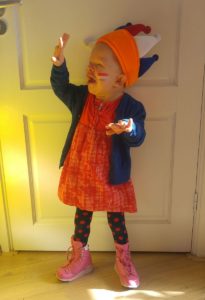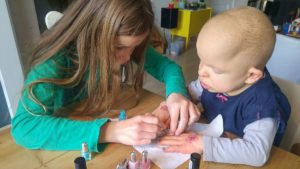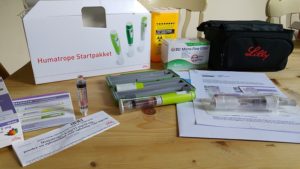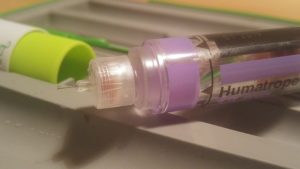In all of 2017, my parents have not written anything about me here, so I guess I will have to do it myself. 
Helloooo, everyone! You guys are probably wondering how I am doing. I am five years old now and things are going very well. For those I haven’t seen or talked to in a while, I’ve really said goodbye to my baby and toddler years. I am a Kindergartener now. I’ve really grown! In many ways. I am taller now. Every evening I get a shot in my bum, luckily I’m quite used to it now. The shot helps me grow, not quite as much as we’d hoped, but it’s something.
I can communicate much better now. I’m using more words and I am stringing them together as well. Here and there I supplement with sign language. Or a joke or a sound. More and more people notice that I certainly understand what they are saying and that I can say something back (when I feel like it).
I’m playing. I still really enjoy watching my iPad (especially when I am tired). But I feel like playing more and more. My parents are surprised sometimes when I’m having a conversation with Monkey or Purk in the hallway, when I open and close doors, wave goodbye and pretend I’m leaving while wearing a hat. Maybe they expected it sooner or maybe later, but I just grab my moments here and there. I am not quite walking by myself yet, but I move in a way and at a pace that works for me. I crawl on my knees, walk with my walker, hold on to furniture or walk behind a chair. Sometimes when I’m wearing my shoes and hold a hula-hoop around me for balance, I can walk a few steps by myself.
 Now that the weather is getting nicer, I also like to play outside. I like to go up and down small inclines with my scoot bike or walker, draw with chalk on the sidewalk or swing on the swing set.
Now that the weather is getting nicer, I also like to play outside. I like to go up and down small inclines with my scoot bike or walker, draw with chalk on the sidewalk or swing on the swing set.
And then sometimes I am just done and I get tired or sad. And then I want mom and dad to hold me on their shoulder or dance with me. And (as some of my Facebook followers already know ;-)), when I feel better I like to “hettebennen” (head banging to some rock music).
I think I like to play more because I am slightly less tired. My heart still takes a lot of energy out of me, but I am sleeping slightly better lately. Mom says I shouldn’t write this because I am still taking sleep medication and I still wake up a couple of times a night, but I think it’s going better. They’re saying I still need to go have a talk with people at a special sleeping hospital, but they have to think about who is going to pay for that for a while, or something about a waiting list…  Which is too bad, because on nights when I do not sleep well, I really do not have a lot of energy and I get upset more easily and I have headaches more often. Mom and dad drink some extra coffee on those occasions, but I can’t have coffee yet. So after I’m done with school (I stay until 1:30 PM) I feel like my day is done already. It still varies a bit. Just like eating.
Which is too bad, because on nights when I do not sleep well, I really do not have a lot of energy and I get upset more easily and I have headaches more often. Mom and dad drink some extra coffee on those occasions, but I can’t have coffee yet. So after I’m done with school (I stay until 1:30 PM) I feel like my day is done already. It still varies a bit. Just like eating.
I still get all of my food through my mic-key button, the tube that goes into my stomach. I happily join in during meal times, if I might say so myself. I look at what everyone is eating and I make sure they put their food in their mouths. Or help them a little. I’m also fairly interested in what’s on my plate. I play around with it and sometimes I take a few bites. At school, there is a group called the EAT-team and they have started to think about how I could start eating for real. I understand there may still be a long road ahead, but I’m open to it. And my parents too, luckily. This way we can keep meal times pleasant at home and at school I get an extra elective called “Learning how to eat”. Who knows what will happen.
I still visit the hospital often. Luckily not for emergencies anymore, it’s always with a letter from a doctor who wants to see me, check up on me, take images, give me medicine or take some blood. In all of 2016, I have been to the hospital 51 times, so I know lots of doctors and nurses well and they always wave at me. When the doctor’s appointment is done, I always get a cookie and then I know we can go home again. Because I like being home the most.
But enough about me. Something big and exciting is coming: we will be moving to a different house this summer! And everything has been taken care of. From this new house, we can still walk to the library, the ice cream store, our bakery and the coffee shop. Because I have to think about my social life, you know. I will get a new bedroom where my bed will be. And there no longer will be a big step up to the front door, so I can go in and out easily with my walker or wheelchair. And inside, there is a lot more room! The wheelchair can be parked in the entrance instead of in the living room and I can use my walker around the house without bumping into everything.  The bathroom is more spacious also, which makes it easier for mom and dad to help me. They are going to make a changing station downstairs, so I don’t have to go upstairs for every diaper change and we can store my diaper supply, boxes with syringes and bottles of medication there as well, so it no longer has to be in my bedroom, which gives me more room for my stuffed animals, nail polish, and books. I’m excited!
The bathroom is more spacious also, which makes it easier for mom and dad to help me. They are going to make a changing station downstairs, so I don’t have to go upstairs for every diaper change and we can store my diaper supply, boxes with syringes and bottles of medication there as well, so it no longer has to be in my bedroom, which gives me more room for my stuffed animals, nail polish, and books. I’m excited!
Time to go, until next time!
Greetings from Vera.

 One of the characteristics of Costello syndrome is slow growth or lack of growth. Adult women who are affected by Costello have an average height of 1.35 m. (4 ft. 4) Vera’s sister Mieke is already taller than that at age 9, so we can get a good picture of how little grown-up Vera will be. And currently, with a height of 85 cm (2 ft. 7), she is very small for a 4.5-year-old. We knew Vera would be small, it is part of her genetic condition after all. But Vera is even below the adjusted growth curve for Costello syndrome. Because many children with Costello syndrome have reduced levels of growth hormones it seemed only logical to have her levels tested at WKZ (Wilhelmina Children’s Hospital). We knew from many parents of children with Costello syndrome that many of them were receiving growth hormone treatment to supplement the shortage to normal levels. And so, we added a new specialist to our list: the endocrinologist.
One of the characteristics of Costello syndrome is slow growth or lack of growth. Adult women who are affected by Costello have an average height of 1.35 m. (4 ft. 4) Vera’s sister Mieke is already taller than that at age 9, so we can get a good picture of how little grown-up Vera will be. And currently, with a height of 85 cm (2 ft. 7), she is very small for a 4.5-year-old. We knew Vera would be small, it is part of her genetic condition after all. But Vera is even below the adjusted growth curve for Costello syndrome. Because many children with Costello syndrome have reduced levels of growth hormones it seemed only logical to have her levels tested at WKZ (Wilhelmina Children’s Hospital). We knew from many parents of children with Costello syndrome that many of them were receiving growth hormone treatment to supplement the shortage to normal levels. And so, we added a new specialist to our list: the endocrinologist.

 And so, the shot in our refrigerator was born. It took some getting used to. We ourselves already had to learn so many medical procedures to care for Vera, and not all of them are pleasant, with this one in particular, giving a shot, it was the first one in which we have to cause our child a little pain for her own good. Of course, she has had dozens of shots and we always held her and comforted her, but now we are the ones administering the shot. It took some getting used to, but after two weeks, we all adjusted, including Vera. The shot is part of it, it only takes a second and Vera is enormously brave; usually she allows it to happen willingly and she doesn’t make a sound. She does like to have control over who can give her the shot (mom or dad?) and where she wants to lie down for the shot. Because she may be small, but she has a big personality.
And so, the shot in our refrigerator was born. It took some getting used to. We ourselves already had to learn so many medical procedures to care for Vera, and not all of them are pleasant, with this one in particular, giving a shot, it was the first one in which we have to cause our child a little pain for her own good. Of course, she has had dozens of shots and we always held her and comforted her, but now we are the ones administering the shot. It took some getting used to, but after two weeks, we all adjusted, including Vera. The shot is part of it, it only takes a second and Vera is enormously brave; usually she allows it to happen willingly and she doesn’t make a sound. She does like to have control over who can give her the shot (mom or dad?) and where she wants to lie down for the shot. Because she may be small, but she has a big personality.
 And, does it help? Vera has been receiving the treatment for 5 months now. The dosage has been increased once because she is still not at normal levels of IGF-1. But Vera is growing and it does seem to go faster than before. She does seem to sleep a teensy bit better on average. We do not see an increase in energy levels yet, but that has a lot to do with her heart condition (more about this later). As with all things, we are patient with this and will see what will happen in the long term. So for now, we will continue with our small shot for our big little Vera.
And, does it help? Vera has been receiving the treatment for 5 months now. The dosage has been increased once because she is still not at normal levels of IGF-1. But Vera is growing and it does seem to go faster than before. She does seem to sleep a teensy bit better on average. We do not see an increase in energy levels yet, but that has a lot to do with her heart condition (more about this later). As with all things, we are patient with this and will see what will happen in the long term. So for now, we will continue with our small shot for our big little Vera.